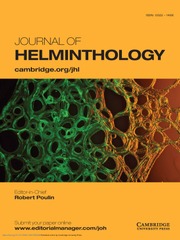Article contents
Development of Fasciola hepatica in Lymnaea columella infected with miracidia derived from cattle and marmoset infections
Published online by Cambridge University Press: 01 March 2008
Abstract
The development of Fasciola hepatica from two species of definitive hosts, i.e. cattle (Bos taurus) and a marmoset (Callithrix penicillata) in the snail Lymnaea columella was determined based on the production of rediae and cercariae and snail survival rate. More rediae and cercariae at 60–74 days post-infection were produced by snails infected by cattle-derived miracidia (cattle group) than by those infected by marmoset-derived miracidia (marmoset group). Among the L. columella parasitized by the marmoset group, the survival rate and the percentage of positive snails were higher than among those parasitized by the cattle group. Eggs of F. hepatica released in cattle faeces were significantly bigger than those released in marmoset faeces. Miracidia originating from parasites that completed their development in cattle were more efficient in infecting the intermediate host. These results suggest that vertebrate-host origin influences the eggs produced by the parasite and the infection rates in the snail host L. columella.
- Type
- Research Papers
- Information
- Copyright
- Copyright © Cambridge University Press 2007
References
- 8
- Cited by


